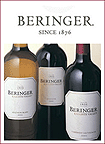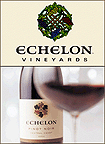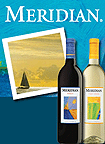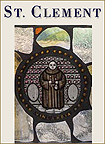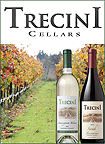|
Guide to Napa Varietals
CHARDONNAY
is the most
widely planted grape variety in the Napa Valley which arguably
produces the best California white wines. In France, the great
white Burgundies are made from the Chardonnay grape and Napa Valley
labels have repeatedly won winetasting competitions against them,
even in France! The Napa Valley makes several types of Chardonnay,
ranging from fresh, crisp wines reminiscent of Pippin apples to
wines rich with toasty and oaky flavors. With such a wide range
of styles, Napa Valley Chardonnays accompany a variety of dishes,
from simply prepared seafood to lighter red meats.
 CABERNET
SAUVIGNON is the acknowledged "king"
of red grapes in the Napa Valley. Some Napa Valley Cabernet vines
from the 19th century are still alive, but most Cabernet vineyards
have been replanted during the last 20 years. Cabernet Sauvignon
is a complex grape; its character can emerge as black currents,
green olives, herbs, bell peppers or combinations of these with
mint and leather. These wines age beautifully. When young they
are best matched with robust red meat dishes; older Cabernets
are superb accompaniments to roasts and steaks, and also complement
many kinds of cheeses. CABERNET
SAUVIGNON is the acknowledged "king"
of red grapes in the Napa Valley. Some Napa Valley Cabernet vines
from the 19th century are still alive, but most Cabernet vineyards
have been replanted during the last 20 years. Cabernet Sauvignon
is a complex grape; its character can emerge as black currents,
green olives, herbs, bell peppers or combinations of these with
mint and leather. These wines age beautifully. When young they
are best matched with robust red meat dishes; older Cabernets
are superb accompaniments to roasts and steaks, and also complement
many kinds of cheeses.
MERLOT
has long been available in the Napa
Valley in small plantings. Traditionally used as a blending
wine, Merlot gained popularity in the early 1970s. Wines made
from Merlot show lovely cherry-like aromas with hints of their
sibling Cabernet's herbaceousness. Because Merlot's tannins are
softer than those found in Cabernet, the wines are drinkable at
an earlier age than most Cabernets. At the same time, Merlots
reward aging by gaining finesse and complexity much as Cabernets
do. Serve Merlot with any dish that calls for Cabernet and try
it even with some lighter meats.
SAUVIGNON
BLANC grapes make wines that appear
under two names: Sauvignon Blanc and Fume Blanc (a regional French
nickname is "blanc fume"). These wines are becoming increasingly
popular because they have a distinctive character, often described
as fruity with a touch of herbaceousness, and very good acidity.
As with chardonnay, you will find a range of styles - those that
are a bit tart and "grassy" and others that have a ripe pineapple
richness augmented by an oak bouquet. Because of their acidity,
Sauvignon Blanc and Fume Blanc are especially enjoyable with shellfish
and seafood.
PINOT
NOIR has been called the fickle grape
variety because it makes some of the world's best wines (the red
wines of Burgundy) but is also one of the most difficult grapes
both to grow and vinify. In France the wines are exceptional only
a few years in a decade. In California it has taken decades to
make relatively few great wines, though much progress has been
made in the last eight to 10 years. Pinot Noir is less tannic
and has less pigment than Cabernet and Merlot so the wines are
somewhat lighter. They can be very drinkable at two to five years
of age and the best will improve for several years after that.
ZINFANDEL
one of California's most versatile
and friendly grape varieties, was the mainstay of 19th century
winemaking. Most of theworld's Zinfandel acreage is planted in
California and is now very popular as a white or "blush" wine,
although it is also vinified as alight, easy-drinking red and
a heavier, richly flavored version that rewards bottle aging.
With such a range of wine types, there is a Zinfandel for just
about every wine enthusiast and for every imaginable food.
GAMAY
and GAMAY BEAUJOLAIS are two different
grape varieties that make wines that are generally fresh, fruity,
lighter reds meant to be enjoyed when relatively young. The Gamay
grape is the chief variety of the
Beaujolais region of France, though somehow the name "Gamay Beaujolais"
was mistakenly applied in California to one of the many varieties
of Pinot Noir.
CHENIN
BLANC is the white grape variety
of Vouvray in the Loire Valley of France. In the Napa Valley it
is often used to create similar wines - delicately fragrant and
slightly sweet - though it also makes very nice dry wines, and
is sometimes aged in oak.
WHITE RIESLING also called Johannisberg
Riesling, is the grape from which most of the great wines of Germany
are made. This varietal yields wines that are fruity and spicy,
usually off-dry or semi-sweet. Occasionally the "noble rot" will
work its magic on Riesling, concentrating the sugars and flavors
resulting in some very sweet wines that smell like honey and apricot
nectar.
THE
RHONE VARIETALS chiefly Syrah among
the reds and Viognier among whites, and ITALIAN VARIETALS,
primarily Sangiovese, are beginning to appear in small quantities.
Source:
Napa Valley Vintners Association |



 CABERNET
SAUVIGNON is the acknowledged "king"
of red grapes in the Napa Valley. Some Napa Valley Cabernet vines
from the 19th century are still alive, but most Cabernet vineyards
have been replanted during the last 20 years. Cabernet Sauvignon
is a complex grape; its character can emerge as black currents,
green olives, herbs, bell peppers or combinations of these with
mint and leather. These wines age beautifully. When young they
are best matched with robust red meat dishes; older Cabernets
are superb accompaniments to roasts and steaks, and also complement
many kinds of cheeses.
CABERNET
SAUVIGNON is the acknowledged "king"
of red grapes in the Napa Valley. Some Napa Valley Cabernet vines
from the 19th century are still alive, but most Cabernet vineyards
have been replanted during the last 20 years. Cabernet Sauvignon
is a complex grape; its character can emerge as black currents,
green olives, herbs, bell peppers or combinations of these with
mint and leather. These wines age beautifully. When young they
are best matched with robust red meat dishes; older Cabernets
are superb accompaniments to roasts and steaks, and also complement
many kinds of cheeses.


